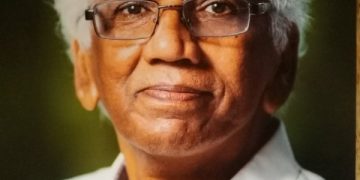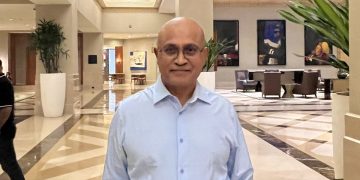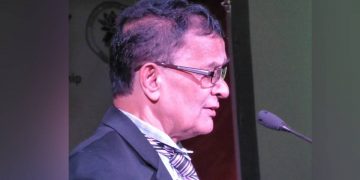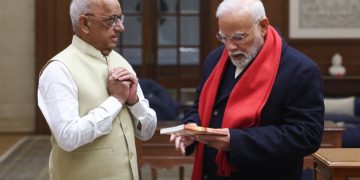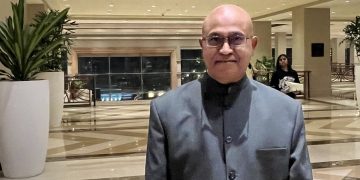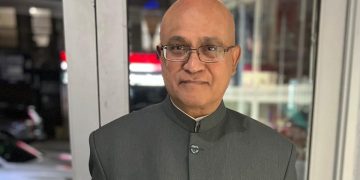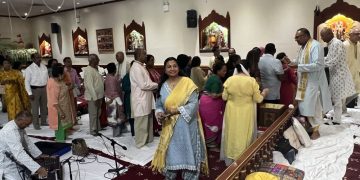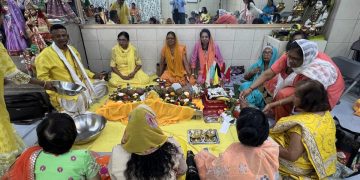A View of D.H. Singh’s Hariji & Hindu Revivalism in Trinidad and Tobago
By Krishna A. Samaroo
D.H. Singh, (popularly known as Dool or Hanoman), retired school teacher and holder of a BA in History and Social Sciences (UWI), is the author of a number of books chiefly on Hinduism and Indian nationals. His latest publication yokes his interest in these two fields as it represents ‘An account of the leadership role of Haripersad Harikissoon in the revival of Hinduism in Trinidad and Tobago between 1972-2015’.
The book is structured into two parts.
In the first half, D.H. Singh offers a compressed biography of the man once known as Pandu in the village of Endeavour, Chaguanas where he was born on 6th August 1945, but who is now known throughout Trinidad and Tobago and beyond as Hariji.
It is this transformation that the writer seeks to make sensible to his readers as he traces within five highly-packed chapters the life of Haripersad Harikissoon from Hariji’s co-founding (with Pandit Ashram Maharaj) in 1972 of the Endeavour Hindu Youth Organization and the Ramanand Sagar Kirtan Mandali to his assistance to the Tobago Hindu Society in its present day bid to build the first Hindu temple on the island of Tobago.
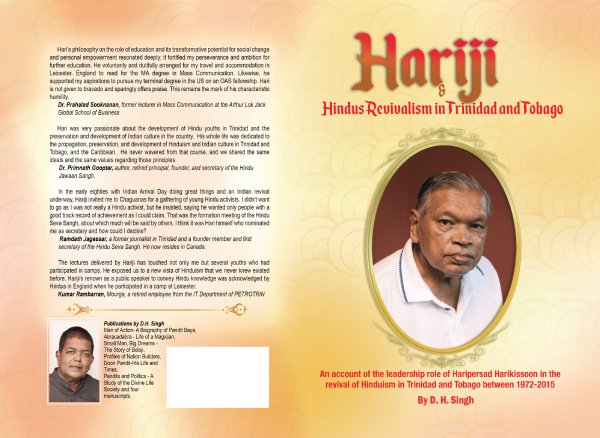
Fittingly, the launch of the publication on Saturday 6th August at the Sri Ram Mandir on Rodney Road, Endeavour, Chaguanas, coincided with a Satsang celebrating Hariji’s 77th birthday.
The idea behind both the launch and the birthday Satsang was to honour the guest ‘while he is alive rather than posthumously.’
As with any attempt at sketching a biography of anyone, it is the familiar and the popular notes that would resonate in the hearts of readers. There is no dearth of this in the case of Hariji.
Readers learn of his association with the writer Ken Parmasad and the lecturer turned politician Dr. Surujrattan Rambachan in their formative undergraduate years at UWI when the Society for the Propagation of Indian Culture (SPIC) was founded.
We are made privy to the union of Hariji and Raviji. It was Raviji who, to date, has made the greatest compliment to Hariji by confessing to D.H. Singh that while he (Raviji) was educated at one of the finest universities in the world, Banaras Hindu University, Hariji ‘who had not, is so knowledgeable of Hindu dharma.’
We learn of the split between the two when Raviji left the Hindu Seva Sangh to establish the Hindu Prachar Kendra. (The Hindu Seva Sangh, founded by Hariji in 1983, was the successor to the Hindu Jawaan Sangh which had functioned as a national Hindu youth organization from 1975 to 1979 until becoming the Youth Arm of the Sanatan Dharma Maha Sabha.)
How Indian Arrival Day May 30th came to be declared a public holiday honouring the Indentured immigrants from India who came to these shores between 18545-1917 is detailed with Hariji’s association with well-known journalist, Ramdath Jagessar.
Within the pages of the first section, D.H. Singh squeezes in, through references and narration, the extent of Hariji’s involvement in the erection of statues honouring the Indian Indentured workers at Cedros, Seedas Sadhu at the Waterloo Cremation Site and legendary Chutney singer, Sundar Popo at Debe.
The revival of Phagwa and Chowtal Sammelan is also credited to the towering figure of Hariji when he rose to become an executive member of the Sanatan Dharma Maha Sabha.
The effervescent Mungal Chattergoon makes his appearance in the book with his attempt to produce a bi-monthly newspaper, the Trinidad and Tobago Patriot, as well as his role in the transformation of the Divali Song Festival into the Secondary Schools Sanskritik Sangam. (For primary schools there is the Baal Vikas Festival.)
Interestingly enough, at the birthday Satsang and book launch, it was publicly declared that Hariji and Mungal Chattergoon shared a special bond.
If the first half of the book can be taken to represent the foundation of a house in the making, D.H. Singh in the second half complements it with the finishing touches. This he does by giving us the tributes of 27 persons whose lives were deeply touched in one way or the other by Hariji.
It is through the testimony of these individuals that we learn that Hariji was a brilliant man and extremely knowledgeable of the Hindu Shastras, Vedanta and Hinduism in general. That he introduced Bhagavad Gita slokas, Ramayan chaupais and dohas to be taught, chanted and memorized in satsanghs. That he introduced to many the teachings of Swami Vivekananda and Satya Sai Baba. That he believed the youths held the future in their hands. That he sponsored Youth Training Camps that trained hundreds of youths across the country. That he helped create dynamic, brave and confident personalities who are leaders in their communities. That he played an integral role in the lives of many.
Individuals spoke profusely of his dedicating his life to the propagation, preservation and development of Hinduism and Indian culture in Trinidad and Tobago and the Caribbean. Of his pet subject being the state of the Hindu community in Trinidad and Tobago. Of there being few persons like Hariji who dedicated over 50 years of their lives to the protection of Dharma. Of how Hariji lived unapologetically for Sanatan Dharma. Of how he staunchly believed that if you protect Dharma, Dharma will protect you.
Tributes are suffused with the opinion that he possessed great oratorical skills. That he was an excellent speaker with great knowledge of Sanatan Dharma, its heritage and history.
Equally permeating the tributes are the qualities Hariji possesses. That he was a simple man who exuded an aura of peace, integrity, and total usefulness. A person who never sought publicity or public accolades and honour. His modesty endures as an endearing trait.
Hariji many saw as an educator, a religious and cultural activist, nationally, regionally and beyond.
What D.H. Singh seems to be saying to his readers by inserting these tributes into the second half of the book is that we should not take alone his word for the glowing way in which he himself presented Hariji in the first half of the book, but that we should heed the words of the 27 individuals whose testimonials comprise the second half.
Hariji had a vision for the spread of Hinduism that many had never seen in any other individual. That is the thesis of D.H. Singh’s book.
Through his writing, D.H. Singh continues to show, with this publication, that he, too, like his subject, Hariji, is unapologetically serving the cause of Sanatan Dharma.
Stylistically, it is well printed, has a lovely feel to it, and in terms of cost, really a give-away considering the wealth of information contained within its 112 pages.
